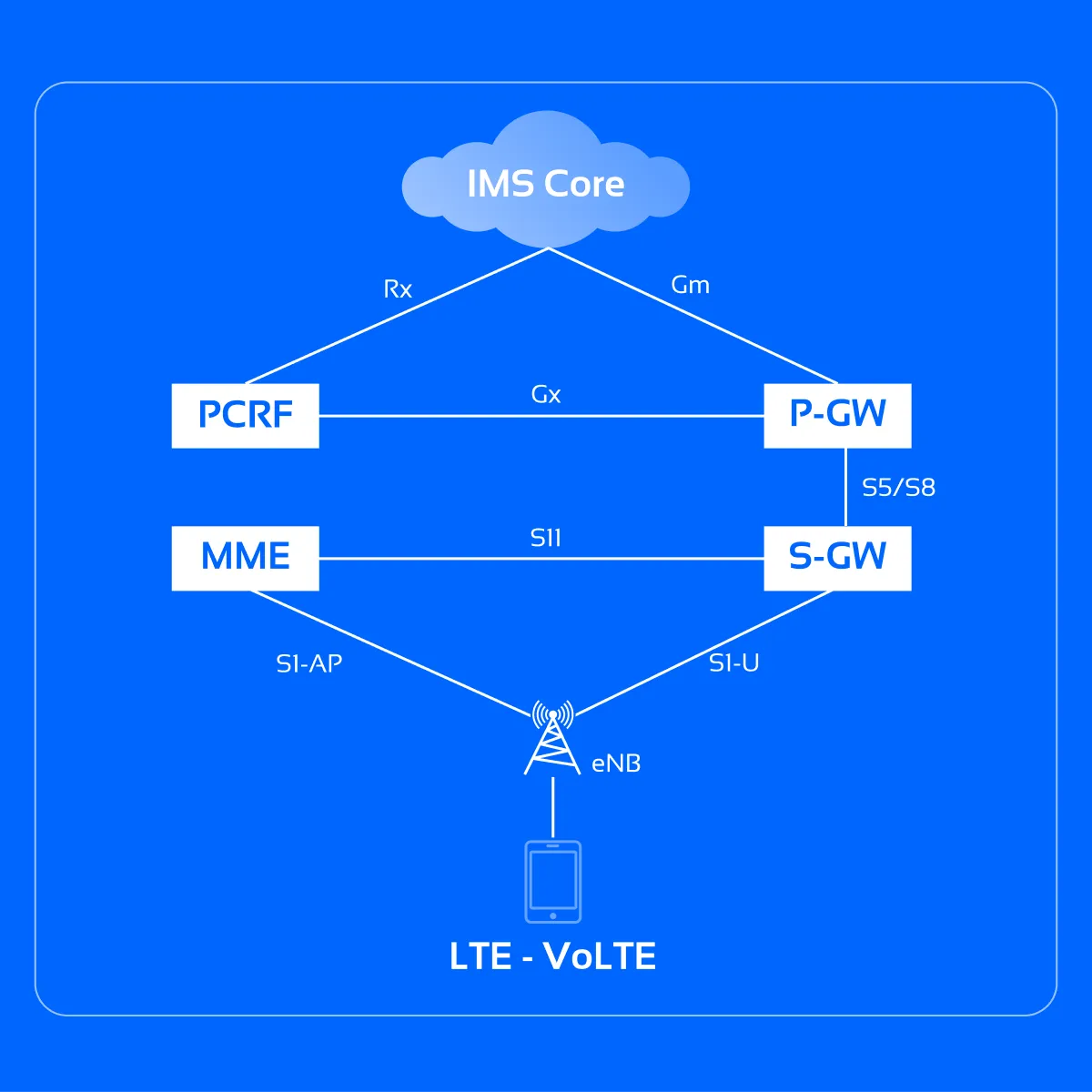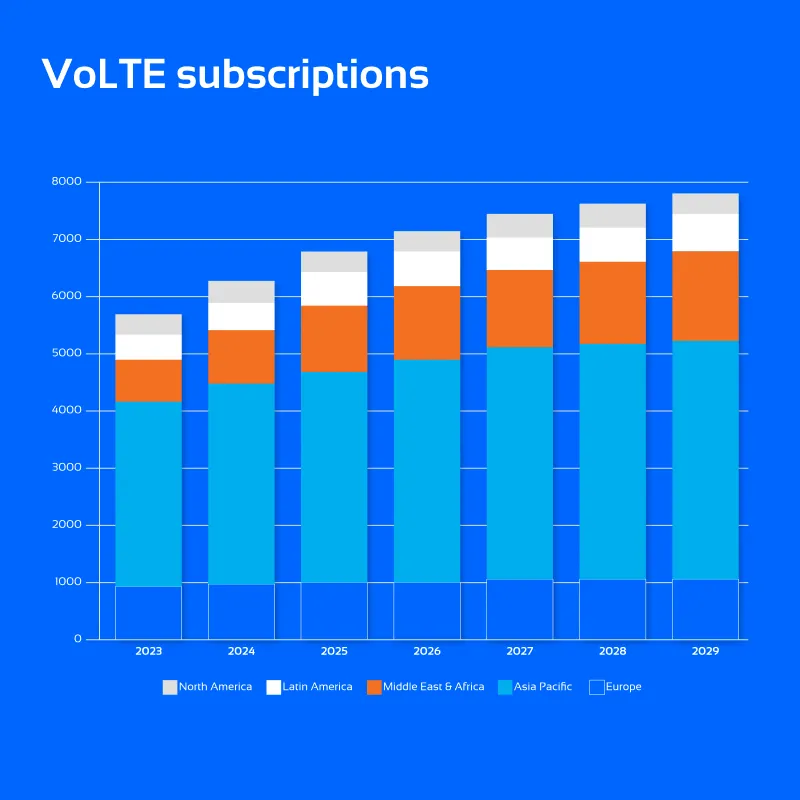
.webp)
As mobile networks continue to evolve, the transition from legacy circuit-switched voice services to packet-switched Voice over IP (VoIP) technologies has become increasingly important, and Voice over LTE (VoLTE) is the new standard for voice over 4G networks. Here is an overview of what VoLTE is, the benefits it brings to service providers and, more generally, the transition operators need to make to future-proof their networks.
VoLTE represents a significant leap forward in mobile communications, moving from traditional circuit-switched voice services to an all-IP-based system. VoLTE leverages the IP Multimedia Subsystem (IMS) architectural framework to enable voice services over any 4G, 5G, WiFi, or other data network. This technology allows mobile operators to use their 4G LTE infrastructure for both data and voice services, improving network efficiency and capacity. VoLTE eliminates the need for separate voice and data channels, allowing devices to maintain a single radio connection for all services. This consolidation not only simplifies the network architecture, but also paves the way for enhanced user experiences and new communications capabilities. As the mobile industry continues to evolve, VoLTE serves as a critical stepping stone between legacy voice systems and future technologies such as Voice over New Radio (VoNR) in 5G networks. It bridges the gap between traditional cellular voice calls and Internet-based communication services, providing a standardised approach to delivering high-quality voice services over advanced mobile networks. Implementing VoLTE requires compatible devices, network support and often user activation. As mobile operators around the world continue to invest in and deploy VoLTE technology, it is becoming an increasingly integral part of the mobile landscape, setting the stage for the next generation of voice services in the era of advanced mobile networks.
A VoLTE (Voice over LTE) call works by using the LTE data network to transmit voice as IP packets, providing higher voice quality and lower latency than traditional voice services. The process begins with initialisation, where the user's device and the LTE network establish a Session Initiation Protocol (SIP) session to verify network capabilities and user permissions. Once the call is initiated, the voice signal is digitised and encoded into compressed audio on the phone's chipset using a codec such as AMR-WB or EVS. The encoded audio is then converted into IP packets and transmitted over the LTE network. These packets travel through the network core on QoS-prioritised bearers, ensuring consistent quality and low delay. At the receiving end, the packets are received and decoded by the phone's chipset, which reconstructs the original audio signal for playback on the recipient's device. Finally, when the call ends, the SIP session is terminated and the resources allocated to the call are released, completing the process. This seamless integration of voice and data networks enables VoLTE to deliver clear and efficient communications.
Voice over LTE (VoLTE) offers a range of advanced features and capabilities that significantly enhance the mobile communication experience. One of its primary advantages is the delivery of crystal-clear voice quality through HD voice technology, utilizing wideband audio codecs like AMR-WB. VoLTE enables faster call setup times, typically connecting calls in less than 2 seconds compared to the 7+ seconds required by traditional networks. A key capability is simultaneous voice and data usage, allowing users to maintain high-speed data connections during calls without interruption or degradation of service. VoLTE also improves spectrum efficiency, offering up to three times more voice and data capacity than 3G and up to six times more than 2G. The technology supports advanced features like video calling (ViLTE) and seamless integration with Voice over Wi-Fi (VoWiFi), enhancing indoor coverage. VoLTE is optimized for low battery consumption, making it ideal for power-constrained devices. Additionally, it enables rich communication services (RCS), providing a more versatile messaging experience. These features collectively contribute to an improved user experience, increased network efficiency, and pave the way for future voice technologies in 5G networks.
The Voice over LTE (VoLTE) architecture integrates voice services into the LTE network using IP Multimedia Subsystem (IMS) technology. It consists of several interconnected components including the User Equipment (UE), which are VoLTE-capable mobile devices, LTE Radio Access Network, which manages radio resources and connections, Evolved Packet Core (EPC), which manages functions such as mobility, authentication, and connectivity to external networks, and the IP Multimedia Subsystem (IMS), responsible for the delivery of IP multimedia services.

Within the EPC key network functions for VoLTE include the Mobility Management Entity (MME), the Serving Gateway (S-GW), the Packet Data Network Gateway (P-GW) and the Policy and Charging Rules Function (PCRF).
More specifically, here is the role of each of them.
A key difference between OTT VoIP and VoLTE is how the media flow is handled on the mobile network. While a regular VoIP call is handled like any other IP traffic on the mobile network with best effort transport, a VoLTE call is handled by a prioritised, dedicated data channel (dedicated bearer) with guaranteed bandwidth, specifically designed to carry voice traffic. Unlike a regular VoIP call, the audio codec (AMR/AMR-WB/EVS) is specifically designed for this traffic and takes into account the characteristics of the mobile network.
Configuration management is also simplified as the VoLTE call is authenticated and provisioned by the network and SIM card, eliminating the need for user interaction. It is highly optimised to work on the handset, avoiding unnecessary battery drain: Call, signalling and media handling are handled by the chipset, eliminating the need for any kind of user application.
VoLTE deployments continue to expand as service providers use the IP Multimedia Subsystem (IMS) to enable mobile voice services on both 4G and 5G smartphones. The adoption of VoLTE has become widespread across networks worldwide, complementing the emerging rollouts of Voice over New Radio (VoNR) for 5G Standalone (SA) networks, as well as Video over New Radio (ViNR). As the chart below from the Ericsson Visualizer shows, global VoLTE subscriptions are expected to grow steadily over the coming years. By the end of 2024, the number of VoLTE subscriptions is expected to reach 6.3 billion, reflecting significant penetration in all regions. This growth is particularly pronounced in Asia-Pacific, which consistently holds the largest share of VoLTE subscriptions. By 2029, the number of VoLTE subscriptions is forecast to rise to 7.8 billion, accounting for around 90% of all 4G and 5G subscriptions combined. This strong growth is partly fuelled by the obsolescence of legacy technologies such as Circuit-Switched Fallback (CSFB), which rely on 2G and 3G networks for voice services. As these older networks are decommissioned, the transition to VoLTE, VoNR and IMS-based services will continue to accelerate globally. The regional breakdown shows significant differences in penetration levels. Asia-Pacific dominates with the largest share, followed by Europe and the Middle East and Africa. North America and Latin America are also experiencing steady growth, but to a lesser extent than the other regions. The global expansion of VoLTE, combined with the phasing out of legacy voice technologies, signals a future where IMS-based voice services will become the standard for most mobile users worldwide.

To effectively address the multiple challenges and pressures facing modern mobile networks, operators must prioritise solutions that increase network flexibility, reduce operational costs and generate new revenue streams.
To meet all these challenges at once, ng-voice has developed the first fully cloud-native IMS in the market: the Hyperscale IMS Solution – infrastructure-agnostic, cost-efficient and fully automated.
Designed to work on any infrastructure layer, this solution guarantees complete flexibility of deployment, whether on bare metal, private or public cloud, as well as on any type of orchestration layer. The Hyperscale IMS not only promises unparalleled adaptability, but also delivers up to 80% total cost of ownership (TCO) savings due to its extremely low resource footprint and high levels of automation. The result is an easy-to-operate solution with unparalleled deployment time and a simplified life-cycle management.
The backbone of this architecture is the Container-as-a-Service (CaaS) platform, powered by Kubernetes and built with lightweight containers, all 25MB or smaller. This ensures that services are always available, scalable, and efficiently managed.
At a time when voice revenues are declining for operators, the Hyperscale IMS is the perfect solution for any M(V)NO, IoT provider or private network providers.
By using this website, you agree to the storing of cookies on your device to enhance site navigation, analyze site usage, and assist in our marketing efforts. View our Privacy Policy for more information.
